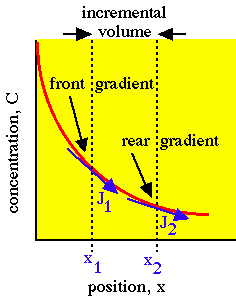Self-limiting parabolic growth
In the last post, I hinted that the parabolic growth law that oil reserve growth estimates seem to follow will likely hit some hard limit. After all, no one really believes in an infinite supply of oil .. do they?
I use the physical analogy of diffusion to come up with a model for reserve growth in this regime. In chemistry and materials science, engineers use the principle of diffusion all the time to estimate rates. A simple formulation, known as Fick's first law, supposes that the rate of material flow remains proportional to the concentration gradient across a range of spatial distances. This works ideally for conditions of fixed concentration with respect to time at the boundary conditions. Fick's second law makes the assumption that the concentrations can change over time, and a more complicated partial differential equation results.
Under the first law, the rate of transport (and therefore growth) tracks proportionally the concentration difference and inversely the distance between the opposing concentration layers. If the "growth" amounts to transferring material from one side of the layer to the other, the diffusivity D assists the flow from the high concentration area (C(0)) to the low concentration layer (C(x)), while the continued growth on the other side starts to retard it.
dG(t)/dt = D (C(0)-C(x))/G(t)

This flow becomes self-limiting only in the sense that it starts to progressively slow down. However, given enough time, diffusion happens and it will continue to grow indefinitely. In a material analogy, the oxides that form on silicon occur immediately and then start to slow down as the oxide gains thickness forming an increasingly impenetrable membrane. This gives the parabolic growth law -- perhaps better entitled the square root growth law -- which states that G(t) ~ sqrt(t).
The connection to oil reserve estimates mostly comes from making an analogy: that the geologists can only predict what they can measure, and they can measure the oil at the low concentration layer, having to wait decades for the high concentration layer to "diffuse" across the barrier. Admittedly, the "diffusion" I talk about may not symbolize real diffusion but rather a fixed difficulty in extracting material as we drill deeper, etc. We then will continually achieve diminishing returns, with an added real possibility of hitting hard limits.
 Not wanting to work out the second law, but sensing that the concentration changes with oil depletion, I worked out a modification to Fick's first law whereby I changed the C(x) term to track the growth term G(t). This basically says that over time, the concentration differences start to level out.
Not wanting to work out the second law, but sensing that the concentration changes with oil depletion, I worked out a modification to Fick's first law whereby I changed the C(x) term to track the growth term G(t). This basically says that over time, the concentration differences start to level out.dG(t)/dt = D (C(0)-a*G(t))/G(t)Unfortunately, one can't find an analytical solution to this equation (except for the asymptotic behavior, which drops out straightforwardly). But, alas, we do have computers to do the grunt work of numerical integration. The following curve results for an a/C(0) ratio of 0.09 (the asymptote rather nicely goes to 1/0.09=11.1).

I plotted the 90-year reserve growth from Attanasi & Root (their "common monotone" data fit) on top of the curve so you can see one possible future extrapolation. Clearly, the enigma of miraculous parabolic growth starts to evaporate under this regime and extraction will continually eat away at the meager growth we will get in years to come.
And as I said in the previous post, I await eagerly the latest 105-year data updates from the USGS. This should conclusively show that the reserve growth curves level out as this model would predict.









3 Comments:
Very nice.
You do realise that now you'll have to do another oil shock model post including this info.
Also, it will be interesting to see the next USGS data point, because the chart above seems to suggest that the model and data points follow different trends. The difference would no doubt not be significant, but the suggestion is interesting.
Looking forward to more. Thank you for your trouble.
I will do that but I have to understand if the reserve is truly not available if it is speculatively unmeasurable. If it is mostly available in a speculative sense it won't make much of a difference. If you truly have to defer the discoveries, the tail will lead to a lag smearing of the profile.
Remember that the points around the 90 year extreme have poorer statistics because there are about 14x fewer data points than near the meat of the curve. In other words, the standard deviation error bars are probably about 3-4x greater at the end points.
Another thing that is perhaps worth mentioning...
IF reserve growth, assuming it exists, is fundamentally related to an increased price for oil, then does this not make oil reserves vulnerable to a 'reserve decline' in the face of price declines?
No doubt anyone who reads this will be familiar with the phase, undulating plateau. If it were the case that current price for oil (or any future price) was unsustainable economically (would in time lead to large scale demand destruction), then any increases in reserves that were booked during this time of high prices might no longer be bookable.
Specifically, if the world economy were to hit a significant recession shortly, pulling oil prices back into the realm of say, $40 per barrel, how much of the recent reserve increases would no longer be economical to produce.
By my reading, there does appear to have been a significant reserve appreciation effect in the past. However, I am skeptical of those who would merely extrapolate it into the future.
Post a Comment
<< Home